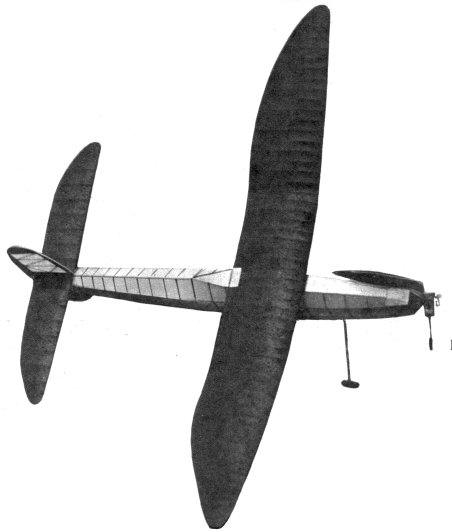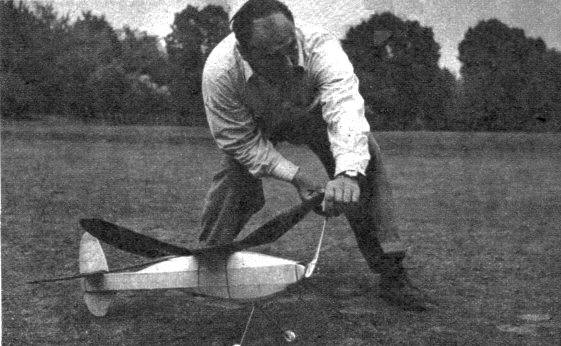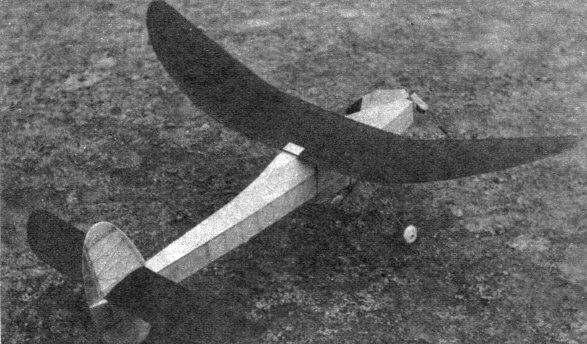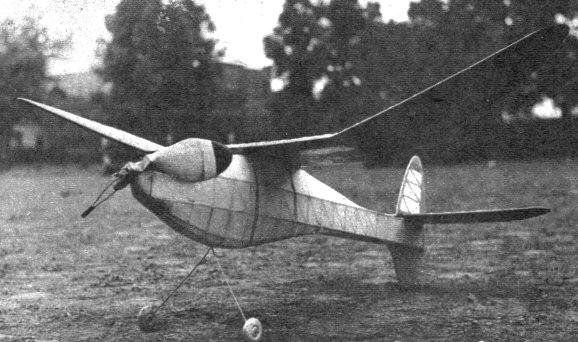|
WAKEFIELD DESIGN Not a "box," yet easily built, this rugged competitor
THIS ship, built to Wakefield specifications, has been named Glamour Girl, because of the many curves in the right places. Tested in a number of contests, Glamour Girl has left little to be desired as far as performance is concerned. The ship has a very fast spiral climb, and a slow, lazy glide. Both climb and glide are to the right. Well, since talking about it will not get it built, let's get started. CONSTRUCTION The fuselage is built up of the two main sides, with 1/8" square longerons and cross braces, and 1/16 x 1/8" diagonals. The diagonals add little weight but give perfect bracing against the twisting strains encountered in high-powered rubber jobs. The diagonals also take up the strain when a longeron snaps in the heat of competition. Choose your material carefully, using hard stock throughout the entire fuselage, as this is where most of the hard knocks will be absorbed. After making the two sides, join together as per plan view of the fuselage. Be sure to use accuracy in scaling up the plans, and follow the dimensions given. After the two sides are joined and dry, sand this part of the fuselage thoroughly, first with medium and then with fine sandpaper. This removes unnecessary weight, and also insures a smooth covering job. Now cut out and cement into place the twelve bottom formers, all of which are cut from 1/16" sheet, medium stock. Former 5 is cross-grained, and made 1/8" thick, as the landing gear is sewed and cemented to it. Do not cut notches for the five stringers on the formers until the formers are cemented into place. You are thus assured of a perfectly lined-up set of stringers, as compared with the usual way of first notching the work. The stringers are 3/32" square, hard stock. At Station 13, the stringers butt against 1/8" sheet cemented to the bottom of the fuselage. The only formers used on the top of the fuselage are at Stations 6 to 10 inclusive. These formers are all exactly alike, and a jig can be used to make them. Cement these five into place; then cement a strip of 1/8" square over the center of the formers, curving it down to meet Station 1 in the front and Station 16 in the back. Fill in with 1/8" cross braces to meet this "spine," as per the plans. A solid block is used in the front, top and bottom, to make the front of the ship more solid and bring out the right balance. Plank the top of the triangle from Station 2 to 6, and from 16 to 20, with 1/16" sheet. The tail plug is unusual only in that it is part of the rudder. It is made with a 1/4" hard balsa cork fitting into the rear of the fuselage to prevent turning. Both front and rear hooks are .050 music wire, bent into safety hooks. Cambric spaghetti is used on both hooks to prevent rubber cuts in the motor. The nose block also has a 1/4" cork into the front of the ship, and is streamlined to the contour of the ship. One degree right and one degree downthrust is used in the nose block. Brass eyelets; .050 I.D., keep this adjustment permanent. The landing gear, made from .063 wire, is sewed and cemented to Former 5, and the wheels used are 2" diameter, of 1/8" cross-grained sheet balsa. Bushings at the hubs prevent any sloppiness. The fuselage can now be covered with Jap tissue, water-sprayed, and when dry, clear-doped twice. The prop is cut from a 1-1/2 x 2 x 9" block, and is a single-bladed folding affair. Most modelers have their own pet way for making a folding prop, so go to it, only be sure to use the dimensions given. Although the prop seems small, it gives a fortyfive-second motor run, powered with eighteen strands of 3/16 x 1/30", forty-four inches long. The crate really climbs during these precious seconds, and flirts with the angels. The stabilizer is made thirty-two percent of the wing area, and is of a high-lift section. No trouble should be encountered in making the stab, as the construction is very simple. After covering and doping, cement to fuselage as per plans at zero incidence. The rudder is built up entirely of 1/8" stock, with 1/16 x 1/8" cross braces and diagonals. A tab is used for rudder control. The under rudder, cut from 1/8" hard sheet, is cemented directly to the bottom of the fuselage. The tail plug fills in the gap between upper and lower rudder and preserves the contour. The wing is of simple construction, with two 1/8 x 1/4" hard balsa spars at the bottom of the wing. This allows quite some flexing, and a wing of this type can take a beating. The half ribs make for a better airfoil section and add little weight. The ribs at the tips are cut down in the usual manner and are plotted from the main rib pattern. Actual tip ribs are not given. Most model builders are able to plot tapered ribs to this station anyway. Sand the wing well, cover with Jap tissue, and spray and dope. Cement the wing hooks and saddle at the center section and place wing on fuselage at position shown on plans by elastic bands running under the fuselage between the two hooks. FLYING The ship should show a nice glide. Adjust for a flat glide with a slight right turn. Do this by shifting the wing forward or backward for balance and moving the rudder tab for turn. When the glide is satisfactory, put in three hundred turns and hand launch. If the ship stalls, add a little downthrust. Keep adding turns in the motor as satisfactory flights are obtained, until full-power flights are made. On one thousand turns the ship will climb in right spirals very fast. The glide is slow, with a wide right turn. Scanned From October 1941 |
|||||



